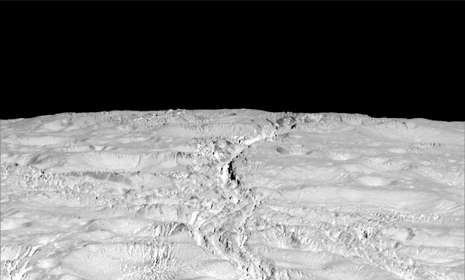http://1.bp.blogspot.com/-NgC99SsNptg/WORHpEGiz_I/AAAAAAAAAqE/-t9TB_RNi2032daUvKqDt8S-dtMRxlAAQCK4B/s1600/Nasa%2527s%2BCassini%2Bspacecraft%2Bto%2Bend%2B20-year%2BSaturn%2Bmission%2Bby%2Bself-destructing.png

On its final mission, threading past hazardous cosmic dust and into hurricanes 1.2bn kilometers away, the Cassini spacecraft will end its 20-year journey with humanity’s closest ever look at what goes on in Saturn’s rings and within its clouds.
On Tuesday, Nasa scientists unveiled their plan for the storied spacecraft, and their reasoning for driving Cassini to its own destruction: with the spacecraft running out of fuel, they do not want to risk it crashing into and contaminating Saturn’s moons, where there may be conditions for alien life.
The tiny moon, Enceladus, in particular, has intrigued the researchers. In 2014 and 2015, Cassini found that the frozen moon has an underground saltwater ocean, with geysers spewing plumes high into space, and possibly hydrothermal vents far below the cracked ice. On a flyby, the spacecraft tasted one of those plumes, finding organic chemicals and raising scientists’ hopes that there may be “a brand new paradigm of where bodies may be inhabitable for life”, said Jim Green, director of Nasa’s planetary science division.
“Cassini’s own discoveries were its demise,” said Earl Maize, the mission’s project manager. “We cannot risk an inadvertent contact with that pristine body.”
On another moon, Titan, Cassini found rivers of liquid methane and yet more organic chemicals, which Green said raised the question of “a different potential life environment” that does not require water or a DNA-based system.
The scientists outlined the fate they’ve devised for Cassini, after 12 years exploring Saturn and its moons. They will direct the spacecraft into Titan’s orbit one last time, using it as a slingshot to drive Cassini into the narrow space – 70,000mph into a 12-mile gap – between Saturn’s atmosphere and its rings, whose fields of dust and debris could threaten the probe. Then Cassini will stay close to the atmosphere, all the while capturing data about the rings and Saturn and using the spacecraft’s antennae as a shield to protect instruments from debris.
“Even a piece of sand at that velocity could take out one of our instruments, or if in the wrong place, could cripple the spacecraft,” Maize said.
The data would be the closest look at Saturn and its rings ever. Project scientist Linda Spilker said Cassini could help solve the mystery of the rings’ origin. If the rings are more massive than expected, she said, they could be ancient, possibly as old as the planet itself. If they’re smaller, they may be as young as 100m years old, she said, “maybe a comet torn apart by Saturn’s gravity”.
Cassini could also reveal the composition of the rings, which are mostly water ice but 1% of which remains a total mystery.
With its instruments toward Saturn, Cassini will capture images and data about the giant hurricanes on the planet’s north and south poles, and the massive and enigmatic hexagon at its northmost reaches. The spacecraft could help answer the question of how the hexagon’s sides stay in place, measure the depths of winds on the planet and capture the first measurements of Saturn’s rocky core
“We’ll actually be peeling back the atmosphere,” Spilker said. “Flying this close to the rings of a planet, that’s a once in a lifetime experience for a scientist.”
Finally, after 22 orbits between the planet and its rings, Cassini will fall into the clouds. “It will break apart, it will melt, it will vaporize, and it will become part of the very planet it left Earth to explore,” Maize said. Twenty years after scientists from 19 nations and three space agencies launched the spacecraft, they will watch it disappear in about three minutes.
“Going out in a blaze of glory is a phenomenal conclusion,” Maize said, praising the decades of discoveries and research that have come from the mission.
“It has essentially rewritten the books on Saturn,” he said, adding he could not help but feel some sadness at the end of an era. “But it’s just a chapter, the book is not complete.”
guardian.co.uk © Guardian News & Media Limited 2010
Published via the Guardian News Feed plugin for WordPress.
Nasa's Cassini spacecraft to end 20-year Saturn mission by self-destructinghttps://goo.gl/V5JWR6











0 comments:
Post a Comment